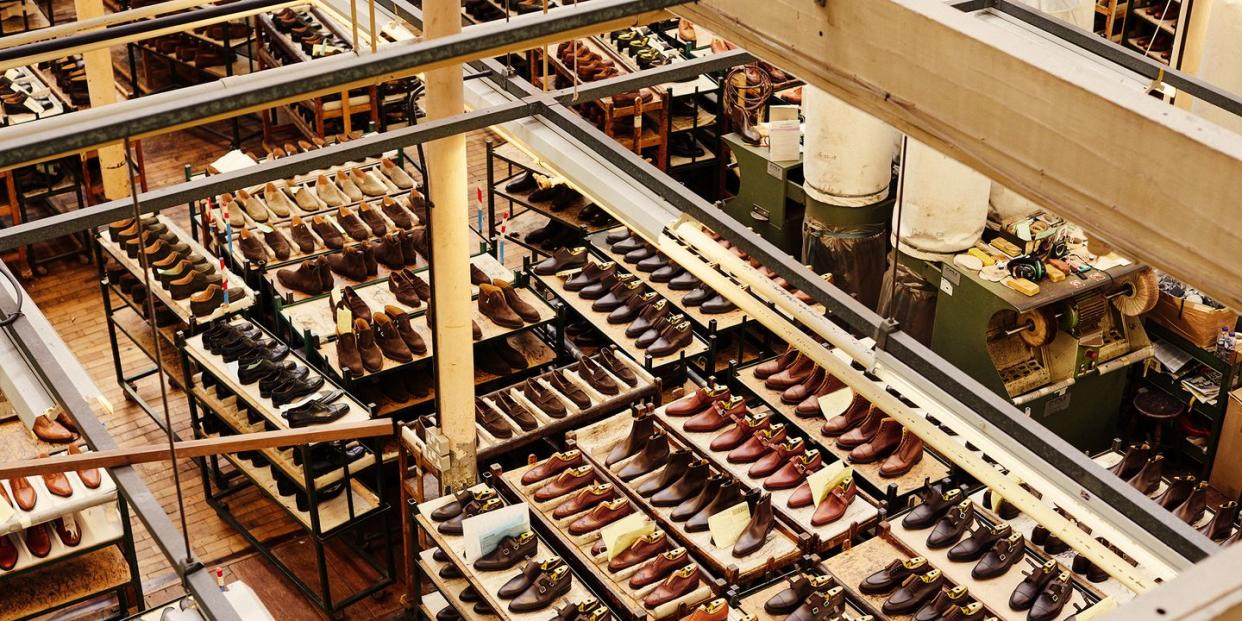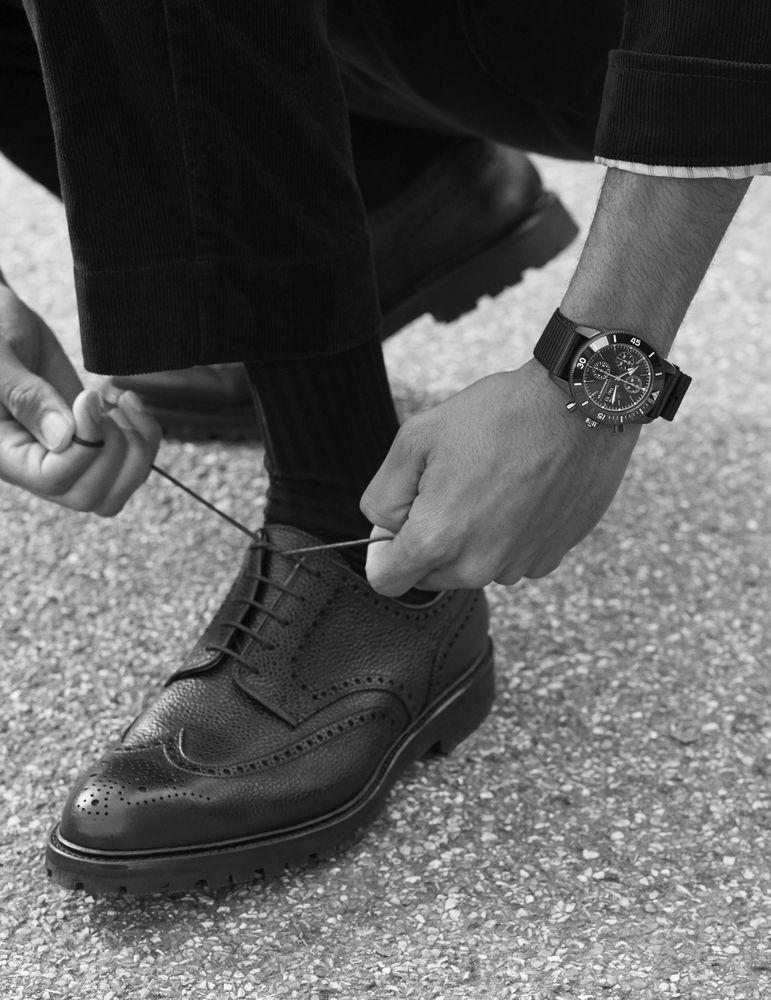Inside Crockett & Jones, the "Bugatti Veyron" of Shoemakers

Above the Dickensian clank and rattle of the factory below, a crack team of shoemakers sits quietly. In this room, daylight pushes through the heavy industrial air and the gentle mumble of local radio is punctuated by soft chatter and the occasional thwack of time-worn metal on new leather. Here is what I’m calling Crockett & Jones’s salvation department. The shoemaker produces thousands of pairs of shoes each week but a small percentage don’t pass muster. Maybe there’s a scratch on the upper or a near-invisible scuff on the heel. A dab of polish that simply hasn’t been polished enough. The quality control team catch it and send the shoes upstairs to the calm of the room that overlooks the factory’s serrated roof. Imperfections are perfected, kinks ironed and swerves set straight.
Brothers-in-law Charles Jones and James Crockett — shoemaker and businessman respectively — founded the company in a workshop in Northampton in 1879. Within 11 years, they had built and moved to a factory in the north of the town that the company still calls home. As Sheffield is to steel and Glasgow is, or at least was, to shipbuilding, so Northampton is to fine shoes: the spiritual and actual home of an industry.
Northampton-made shoes were worn in the American War of Independence in the late 18th century. But the modern industry is built upon the Goodyear welt, an 1869 invention which allowed the upper of a leather shoe to be interchangeable from its sole, which in turn allowed the shoe to be broken down and repaired over and over again. There are variations on the theme but the phrase “Goodyear welted” tends to be the prefix for the world’s finest shoes.

Today, Crockett & Jones has 12 shops worldwide (six in London, two of which are on Jermyn Street), a very healthy export business, a recently-launched e-commerce website and a reputation most companies would envy. Its name is a byword for quality and classic English style. But business hasn’t always been so healthy. In the middle of the 20th century, traditional shoe manufacture slowly slipped into decline, replaced by mass-produced shoes. Companies diversified, outsourced and compromised to stay afloat.
In 1977, incoming managing director Jonathan Jones decided the best way forward would be to focus only on the top of the market. “We had all the machinery and skills to make high-end shoes,” remembers Jones, who is still MD today, “so I thought the only future would be to specialise. Let the other constructions go, concentrate the factory on more top-end making only, and build our exports.”
The top-end making begins in the leather store. The room is jammed with floor-to-ceiling shelves that house great reams of calfskin, suede and grain leather. Depending on the order of the day, a sheaf is hauled into the “clicking” room where the constituent pieces of a shoe’s upper are cut out by hand. “This stuff is as good as you can get,” explains James Fox, head of marketing and my tour guide for the day. “This is your Bugatti Veyron, if you like. No matter what anybody tells you, there are no better calf skins available than these.”
Pieces are then sent to the closing room where they are stitched together and detailing is added: shoes can be “skived”, “gimped” or given a “fancy stitch”, among other things. Fox describes the massive room stuffed with work stations overflowing with off-cuts and sewing machine parts and the odd saucy calendar as a factory within a factory. In the Twenties, there were 300 hand-stitchers. Today there is just one: Ned Fox. He sits on the edge of the melee, stitching a pair every two-and-a-half hours.
In the basement, past the corner that served as an air raid shelter in WWII, is the last room. Here, 40,000 pairs of lasts — the foot-shaped moulds around which a shoe is made — are housed in long, terraced cubby holes, like caged hens. Some are almost a century old, kept for reference or for when aged shoes come in for repair. Roughly eight per cent of Crockett & Jones shoes will be sent back for repair at some point during their lifetime, as indeed they are designed to be. Fox points out that the Coniston boots he is wearing have just been repaired after eight years of wear, and are not new, as I had assumed.
Despite the abundance of options, Crockett & Jones developed a new last shape with a “hollowed-out neck, narrow waist, soft outside wall and an elegantly English round-toe profile” for a capsule collection celebrating the company’s 140th anniversary in 2019. Featuring a Twenties-inspired black Oxford, a slip-on in antique calf skin and a very dandyish tan demi-boot, the trio represents all of the company’s expertise and élan rolled into three.
Back upstairs in the heat and noise of the factory, uppers are gently heated before being wrenched down over their lasts by a machine that hisses and pops as the recognisable shape of a shoe grows into the leather. From here, the shoe is fitted with a Goodyear welt and a sole. A layer of cork is inserted between the two for extra stability and comfort. David Marshall, one of the men manning a welting machine, has been doing so for 45 years and explains that the contraption is essentially the same as it was when he first started in the job.
In the next room — the finishing room, where everything is polished and painted and cleaned and tweaked and checked — Fox introduces me to Charlie McKenzie, who has been working at the factory for 48 years. He sands and trims the edges of soles and heels on a machine that brandishes a terrifying spinning blade. As with almost all of the 200 to 250 operations that go into a pair of Crockett & Jones shoes, a mechanism does the leg work. But a mechanism is useless without the eyes and experience of the staff.
Crockett & Jones faces obvious challenges. The demand for fine handmade shoes is not what it was a century ago (although the new e-commerce website will put them in better stead). Sourcing the best leather is getting harder. And it isn’t easy to entice young people into a factory career, no matter how skilful or rewarding the work might be. But the company has made a habit of keeping its head above water. Beyond that, there is a quiet covenant among the staff to make the shoes as good as they possibly can. For proof, one need only wander through the factory, or pay a visit to the quiet room on the top floor.
This article first appeared in the print edition of Esquire
Like this article? Sign up to our newsletter to get more articles like this delivered straight to your inbox
Need some positivity right now? Subscribe to Esquire now for a hit of style, fitness, culture and advice from the experts
You Might Also Like


